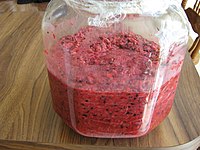
Photo from wikipedia
Monascus purpureus species yield beneficial secondary metabolites copiously including Monascus pigments which are broadly used as food additives, as a nitrite substitute in meat products, and as a colorant in… Click to show full abstract
Monascus purpureus species yield beneficial secondary metabolites copiously including Monascus pigments which are broadly used as food additives, as a nitrite substitute in meat products, and as a colorant in the food industry. Monascus yellow pigments (Monascin and ankaflavin) have shown potential antidiabetic, antibacterial, anti-inflammatory, anti-depressant, antibiotic, anti-cancer, and antiobesity activities. Cosmetic and textile industries are other areas where it has established its potential as a dye. This paper reviews the production methods of Monascus yellow pigments, biosynthesis of Monascus pigments from Monascus purpureus, factors affecting yellow pigments production during fermentation, and the pharmacological properties of monascin and ankaflavin. This article is protected by copyright. All rights reserved.
Journal Title: Biotechnology and applied biochemistry
Year Published: 2022
Link to full text (if available)
Share on Social Media: Sign Up to like & get
recommendations!